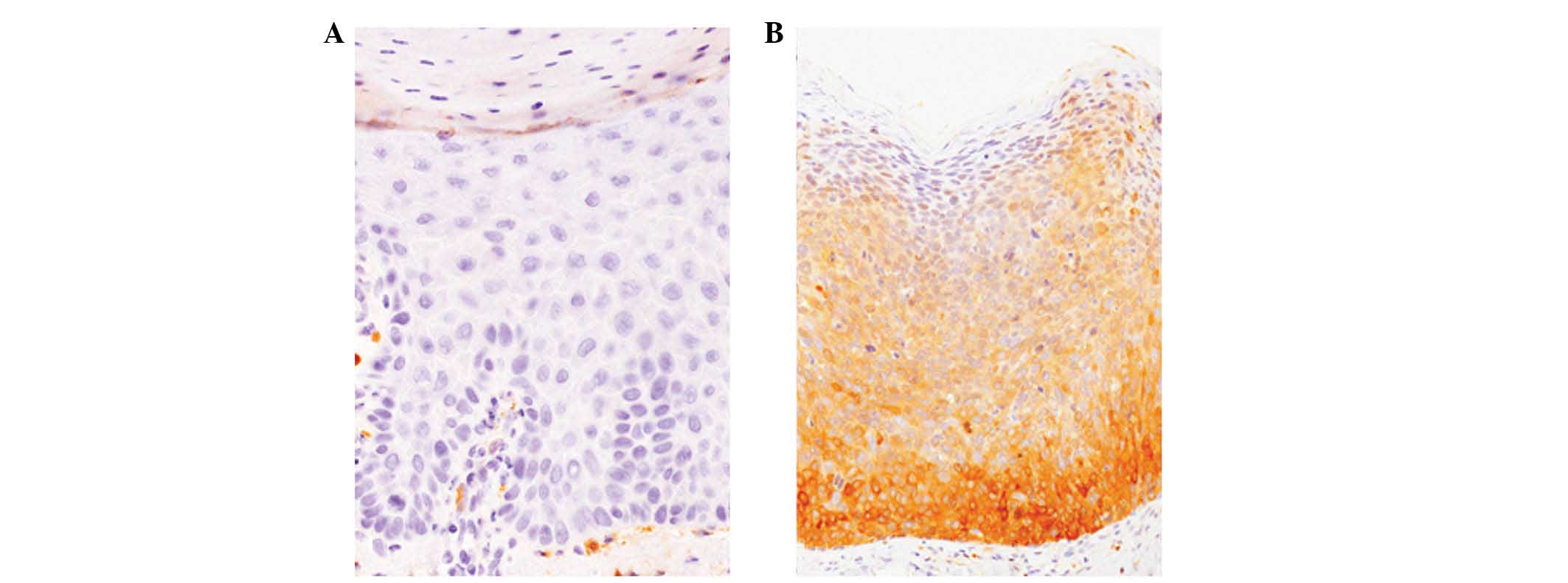Aldehyde dehydrogenase 1 expression in basal cell carcinoma, actinic keratosis and Bowen's disease
- Authors:
- Mitsuaki Ishida
- Hidetoshi Okabe
View Affiliations
Affiliations: Department of Clinical Laboratory Medicine and Division of Diagnostic Pathology, Shiga University of Medical Science, Otsu, Shiga 520‑2192, Japan
- Published online on: April 18, 2013 https://doi.org/10.3892/mco.2013.106
-
Pages:
621-624
Metrics: Total
Views: 0 (Spandidos Publications: | PMC Statistics: )
Metrics: Total PDF Downloads: 0 (Spandidos Publications: | PMC Statistics: )
This article is mentioned in:
Abstract
Aldehyde dehydrogenase (ALDH) is an enzyme responsible for oxidizing aldehydes to carbonic acids. ALDH1 is an isoform that is thought to be a stem cell marker as it is highly expressed in the stem cells of various organs. However, its expression in basal cell carcinoma (BCC), actinic keratosis (AK) and Bowen's disease (BD) of the skin has not yet been analyzed. Twenty‑five consecutive operative cases each of BCC, AK and BD, as well as 10 normal skin tissues were assessed for ALDH1 expression by immunohistochemistry. In normal skin, ALDH1 expression was observed in the suprabasal cells of the follicular infundibulum, inner cells of the outer root sheath and sebocytes. BCC cases (88%) showed no or focal-positive immunoreactivity for ALDH1. Focal immunopositivity for ALDH1 was observed in 44% of AK cases, while the remaining cases were ALDH1‑negative. By contrast, diffuse positive immunoreactivity for ALDH1 was observed in 64% of BD cases. Differential expression patterns of ALDH1 in AK and BD may reflect the distinct cells of origin of these two conditions. Moreover, a low ALDH1 expression in BCC may also reflect the possible origin of BCC, the basal cells of the outer root sheath.
View References
|
1.
|
Sladek NE: Human aldehyde dehydrogenases:
potential pathological, pharmacological, and toxicological impact.
J Biochem Mol Toxicol. 17:7–23. 2003. View Article : Google Scholar : PubMed/NCBI
|
|
2.
|
Black WJ, Stagos D, Marchitti SA, et al:
Human aldehyde dehydrogenase genes: alternatively spliced
transcriptional variants and their suggested nomenclature.
Pharmacogenet Genomics. 19:893–902. 2009. View Article : Google Scholar
|
|
3.
|
Ma I and Allan AL: The role of human
aldehyde dehydrogenase in normal and cancer stem cells. Stem Cell
Rev and Rep. 7:292–306. 2011. View Article : Google Scholar : PubMed/NCBI
|
|
4.
|
Deng S, Yang X, Lassus H, et al: Distinct
expression levels and patterns of stem cell marker, aldehyde
dehydrogenase isoform 1 (ALDH1), in human epithelial cancers. PLoS
One. 5:e102772011. View Article : Google Scholar : PubMed/NCBI
|
|
5.
|
Kossard S, Epstein EH Jr, Cerio R, Yu LL
and Weedon D: Basal cell carcinoma. World Health Organization
Classification of Tumours. Pathology and Genetics of Skin Tumours.
LeBoit PE, Burg G, Weedon D and Sarasain A: IARC Press; Lyon: pp.
13–19. 2006
|
|
6.
|
Sakakibara M, Fujimori T, Miyoshi T, et
al: Aldehyde dehydrogenase 1-positive cells in axillary lymph node
metastases after chemotherapy as a prognostic factor in patients
with lymph node-positive breast cancer. Cancer. 118:3899–3910.
2012. View Article : Google Scholar : PubMed/NCBI
|
|
7.
|
Isfoss BL, Holmqvist B, Alm P and Olsson
H: Distribution of aldehyde dehydrogenase 1-positive stem cells in
benign mammary tissue from women with and without breast cancer.
Histopathology. 60:617–633. 2012. View Article : Google Scholar : PubMed/NCBI
|
|
8.
|
Ginestier C, Hur MH, Charafe-Jauffret E,
et al: ALDH1 is a marker of normal and malignant human mammary stem
cells and a predictor of poor clinical outcome. Cell Stem Cell.
1:555–567. 2007. View Article : Google Scholar : PubMed/NCBI
|
|
9.
|
Michifuri Y, Hirohashi Y, Torigoe T, et
al: High expression of ALDH1 and SOX2 diffuse staining pattern of
oral squamous cell carcinomas correlates to lymph node metastasis.
Pathol Int. 62:684–689. 2012. View Article : Google Scholar : PubMed/NCBI
|
|
10.
|
Minato T, Yamamoto Y, Seike J, et al:
Aldehyde dehydrogenase 1 expression is associated with poor
prognosis in patients with esophageal squamous cell carcinoma. Ann
Surg Oncol. July 31–2012.(Epub ahead of print).
|
|
11.
|
Goldstein J and Horsley V: Home sweet
home: skin stem cell niches. Cell Mol Life Sci. 69:2573–2582. 2012.
View Article : Google Scholar : PubMed/NCBI
|
|
12.
|
Saglam O, Salama M, Meier F, et al:
Immunohistochemical staining of palisading basal cells in Bowen’s
disease and basal involvement in actinic keratosis: contrasting
staining patterns suggest different cells of origin. Am J
Dermatopathol. 30:123–126. 2008.PubMed/NCBI
|
|
13.
|
Ishida M, Kushima R and Okabe H:
Immunohistochemical demonstration of D2-40 in basal cell carcinomas
of the skin. J Cutan Pathol. 35:926–930. 2008. View Article : Google Scholar : PubMed/NCBI
|
|
14.
|
Croker AK and Allan AL: Inhibition of
aldehyde dehydrogenase (ALDH) activity reduces chemotherapy and
radiation resistance of stem-like ALDHhiCD44+ human breast cancer
cells. Breast Cancer Res Treat. 133:75–87. 2012.PubMed/NCBI
|












